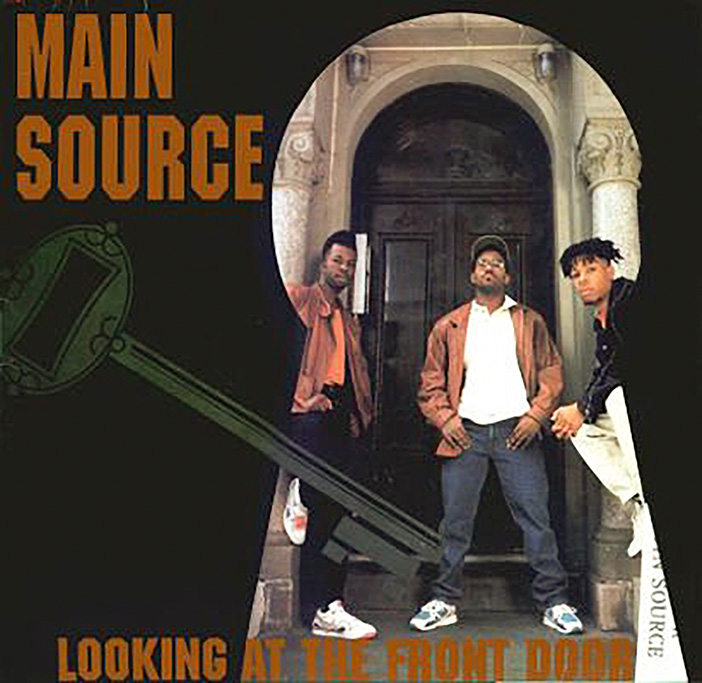Oliver Wang breaks down Main Source’s “Looking At the Front Door” and points out why Large Professor’s production work on this song exemplified sophisticated leaps forward in hip hop song structure.
The first album I ever bought on the strength of a music review was Main Source’s Breaking Atoms, circa 1990. I had been reading The Source Magazine for about a year at that point and they had given the album 4.5 mics: high praise. I vaguely recall the review lauding Large Professor’s production, though, back then, I wasn’t equipped to truly appreciate its full sophistication.
It wasn’t simply that Large Professor had deep crates for sampling. More so than most of his predecessors, he really thought out song structure. Throughout the ‘80s, most rap songs had, at most, a basic verse and chorus, and even then the beat would rarely change much. In the early days when sampling was shifting to become the dominant mode of rap production, it was enough to create a hot loop. If you go listen to the early version of Main Source’s first hit, “Looking At the Front Door,” you can hear how LP had already identified three key loops to work with: the Detroit Emeralds’ drums, the Donald Byrd sample he’d filter for the main sample, and the Pazant Bros.’ “doo-doo-doo-doo-doo-doo-doo” vocal sample for the hook.
But then compare that with the final version that was released. I went through and did a basic breakdown.
Drum fill: 1 bar
Drum intro: 4 bars
Hook 1: 8 bars
Verse 1: 18 bars
Hook 2: 8 bars
Verse 2: 14 bars
Hook 3: 8 bars
Up to this point, both the early and final versions have all the same major samples, but in the final mix, LP has rearranged the structure to give it that short, one-bar drum fill that then transitions into 4 bars of open drums that then goes into the hook. It takes 13 bars just to get to the first verse. That wasn’t unprecedented for a rap song in 1990, but it certainly wasn’t a convention either. In any case, it’s after the third hook that LP takes the song in a new direction and here’s where things get a bit complicated:
First, there’s an 8-bar bridge that takes out the Byrd sample and then adds in a loop from 3rd Guitar’s “Baby Don’t You Cry,” as Sir Scratch and K-Cut get their DJ solos on. Then we return to Verse 3 (16 bars) and another hook (8 bars). Then the DJs get another 8 bar scratch solo over a modified version of the hook with a beefier Byrd sample (i.e. less filtered) but takes out the Pazant Bros. Finally, the song ends with an 8-bar outro that’s basically the 3rd Guitar bridge minus any scratching. That’s 12 different changes over barely 4 minutes.
Again, this is where it’s useful to compare the two versions. The earlier version is about 70-80% similar but what Large Professor adds for the final mix significantly changes our experience of listening to it. “Looking At the Front Door” engineers a structure closer to that of other pop (non-rap) songs and in doing so, the song now has a greater musical narrative alongside the literal story of relationship woe that LP raps about.
And the thing about Breaking Atoms is that it’s not just “Looking At the Front Door,” where you see LP’s craft at work. Many of the songs on the album are sophisticated leaps forward in hip hop song structure (perhaps none as ambitious as “Peace Is Not the Word to Play”). Even over 25 years later, the songs still sound ahead of their time; after all, when’s the last time you heard a contemporary rap song with a clear intro, bridge or outro?
The music and videos below are presented here for the purpose of scholarship.
Main Source – “Looking at the Front Door” (final version)
Main Source – “Looking At the Front Door” (early version)

Maybe I’m wrong, but i always thought the drums were a loop of Gladys Knights cover ; ‘who is he and what is he to you’ layered with the detriot emeralds drums. pretty sure. Great post tho. Love the in depth breakdown of these classics. Cheers